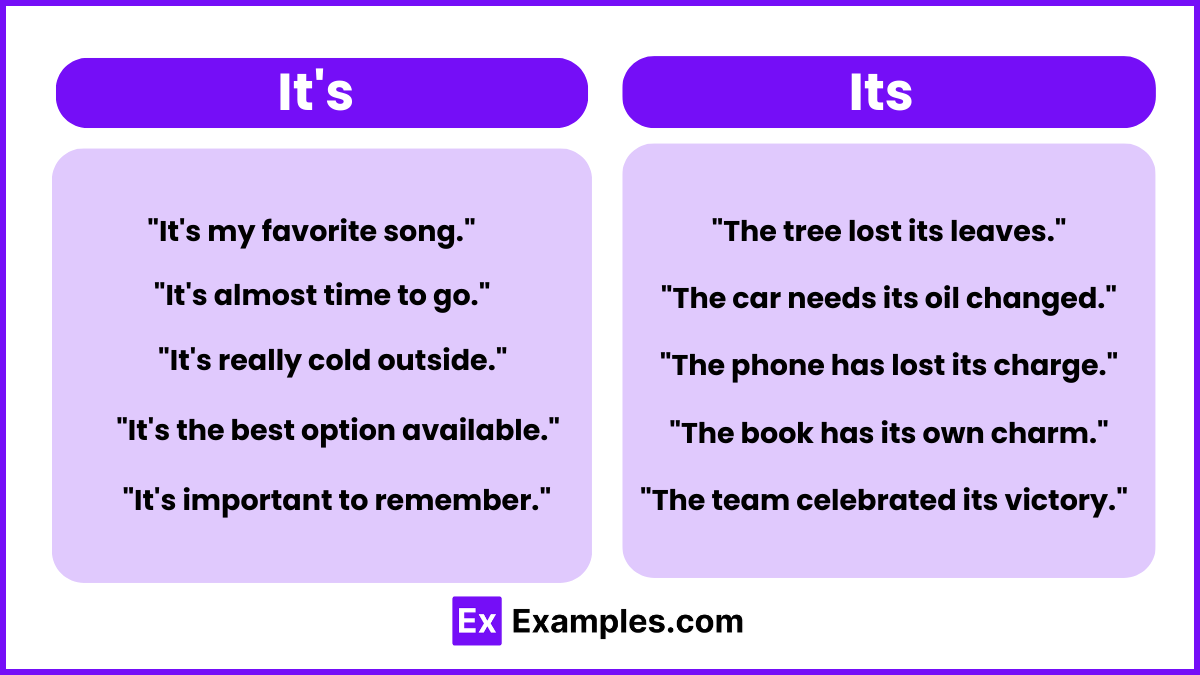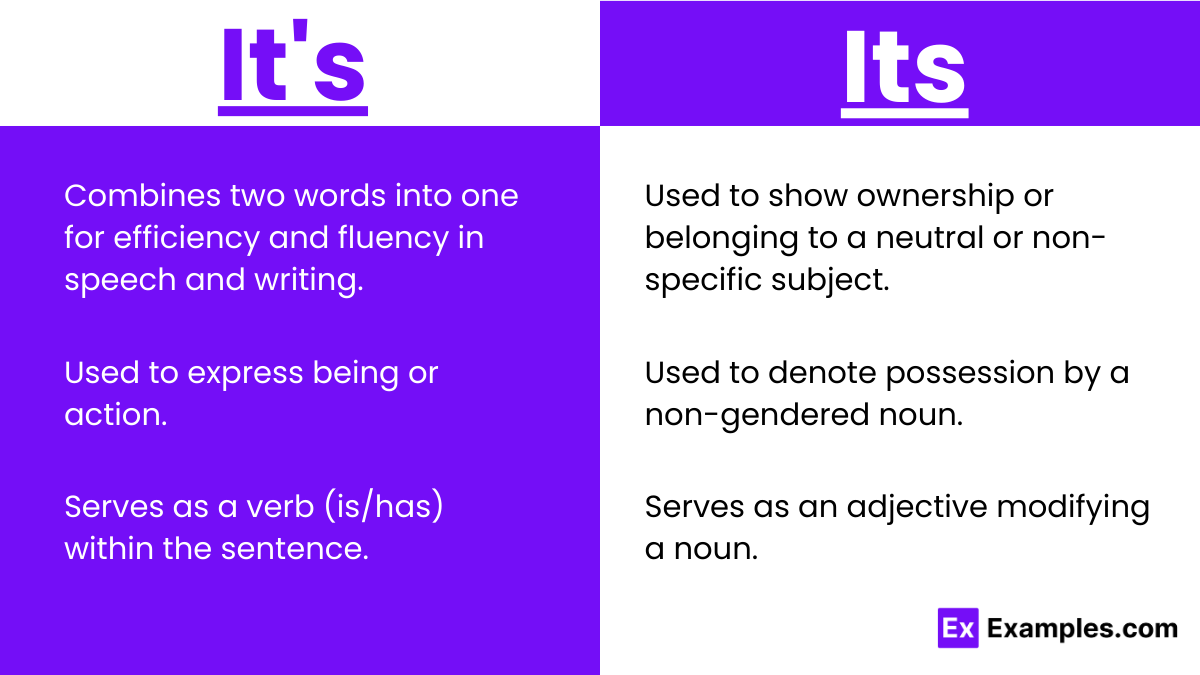It’s vs Its : Examples, Differences, Usage
Students often bump into the tricky decision between “it’s” and “its.” These three-letter words, seemingly simple, hold the key to precise communication. This article is designed to clear up the confusion, offering a straightforward roadmap for understanding and using “it’s” and “its” correctly. With a focus on definitions, real-world examples, and handy tips, we’re here to arm you with the tools you need to conquer this common grammatical hurdle. Perfect for essays, reports, or everyday chats, mastering the difference between these terms will boost your writing skills and confidence in English. Let’s tackle this challenge together and turn it into an opportunity for growth in your language journey.
It’s and Its – Meanings
- “It’s” is a contraction for “it is” or “it has,” used to signify a state of being or possession in a general sense. For example, “It’s raining” means “It is raining,” and “It’s been great” means “It has been great.”
- “Its” is a possessive pronoun, indicating ownership or belonging to something that has already been mentioned or is known. For example, “The cat licked its paw” shows that the paw belongs to the cat.
Difference Between It’s and Its
| Aspect | It’s | Its |
|---|---|---|
| Definition | Contraction of “it is” or “it has.” | Possessive pronoun indicating ownership. |
| Usage | Used to express being or action. | Used to denote possession by a non-gendered noun. |
| Example | “It’s raining outside.” (It is) | “The dog wagged its tail.” |
| Apostrophe Use | Includes an apostrophe to indicate contraction. | Does not include an apostrophe. |
| Replacement Test | Can be replaced with “it is” or “it has” in context. | Cannot be replaced with “it is” or “it has.” |
| Function in Sentence | Serves as a verb (is/has) within the sentence. | Serves as an adjective modifying a noun. |
| Common Errors | Misused for indicating possession. | Misused in place of “it’s” for contraction. |
| Tip for Remembering | Think of the apostrophe replacing the missing letter in “is” or “has.” | Remember no possessive pronouns use apostrophes (his, hers, its). |
Examples of It’s and Its

It’s Examples:
- It’s going to rain today.
- It’s been a wonderful experience.
- It’s important to exercise regularly.
- It’s my favorite movie.
- It’s about time we met.
Its Examples:
- The cat licked its paw.
- The car lost its wheel.
- The plant shed its leaves.
- The company increased its profits.
- The book has lost its cover
How to Use “It’s” and “Its”

Using “It’s”:
- “It’s” is the contraction for “it is” or “it has,” which means it combines two words into one for efficiency and fluency in speech and writing.
- To use “it’s,” first determine if you can replace it with “it is” or “it has” without altering the sentence’s meaning. If the sentence still makes sense, “it’s” is the correct choice.
- Example: “It’s beautiful outside today.” Here, “It’s” can be expanded to “It is beautiful outside today,” maintaining the same meaning.
Using “Its”:
- “Its” is a possessive pronoun used to show ownership or belonging to a neutral or non-specific subject.
- To use “its,” consider if you are indicating that something belongs to or is part of something else, without the need for an apostrophe, which is a common marker of possession in nouns but not used in possessive pronouns.
- Example: “The cat licked its paw.” In this sentence, “its” indicates that the paw belongs to the cat.
When to Use “It’s” and “Its”
When to Use “It’s”:
- Use “it’s” when you can substitute it with “it is” or “it has” in your sentence. This usage is appropriate for conveying actions (is) or experiences/conditions that have happened (has).
- Contexts for “it’s”: Describing states of being, weather, conditions, or actions in the present perfect tense.
When to Use “Its”:
- Use “its” when indicating that something belongs to or is a characteristic of a non-human subject or an inanimate object. “Its” is never used with an apostrophe, aligning with other possessive pronouns (his, her, their).
- Contexts for “its”: Discussing ownership, parts of objects or animals, or characteristics of entities.
In summary, “it’s” is a contraction used for simplification, while “its” is a possessive pronoun used for indicating possession. Recognizing whether you’re indicating possession or contraction (is/has) guides the correct use of “it’s” and “its.”
Where would you use its?
Use “its” to indicate possession by a non-human subject, such as an animal, organization, or inanimate object, showing ownership or a characteristic.
How do you use its in a sentence?
Place “its” before a noun to show the noun belongs to or is part of the previously mentioned non-human subject, without needing an apostrophe.
What is its used for?
“Its” is a possessive pronoun used to express ownership, belonging, or association with a non-human entity, emphasizing a connection between objects or concepts.
Can I use its for a person?
No, “its” is not used for people. For individuals, possessive pronouns like “his,” “her,” or “their” are appropriate, reflecting personal dignity and humanity.



